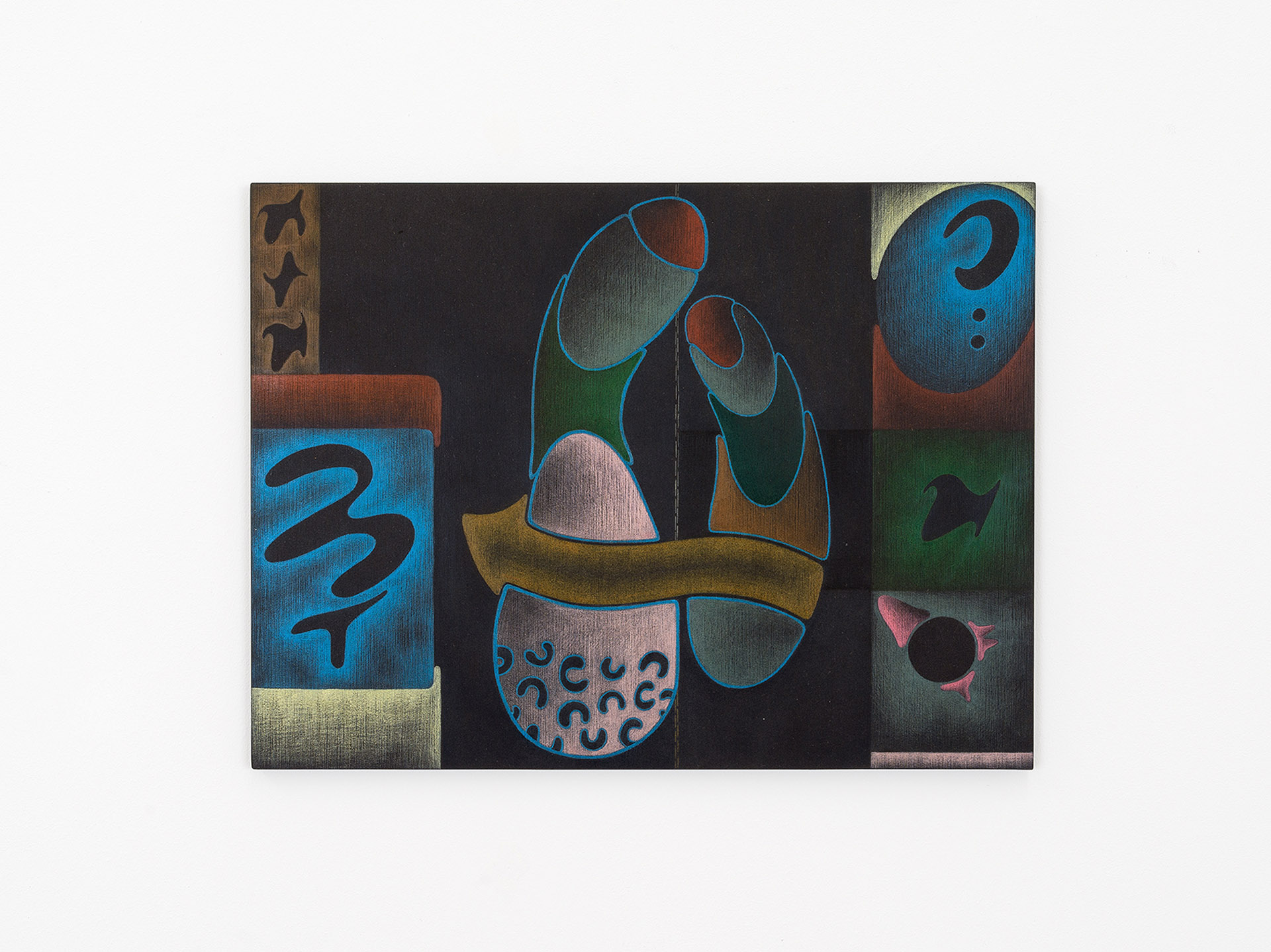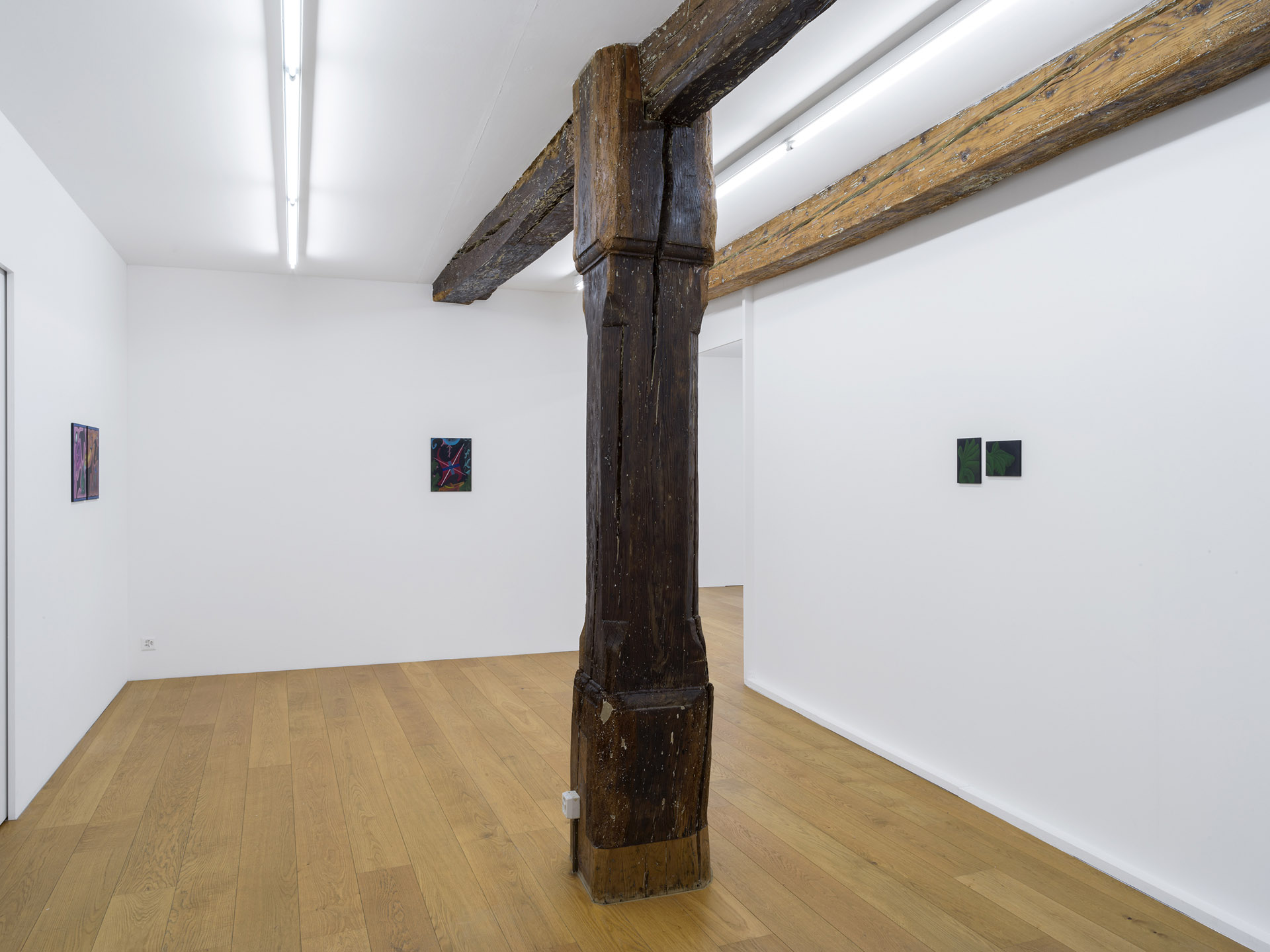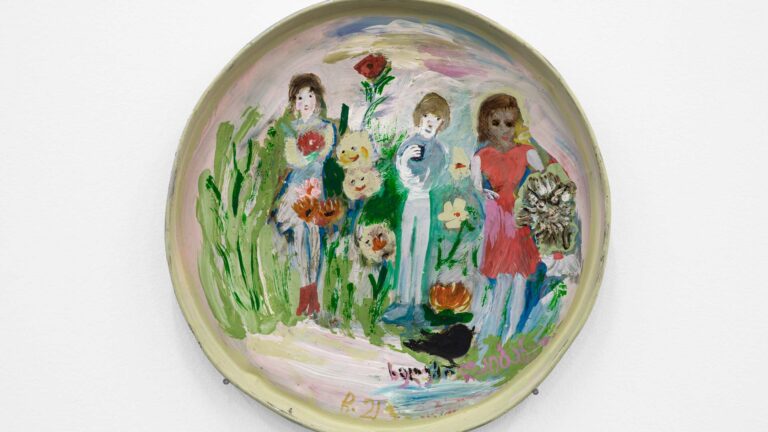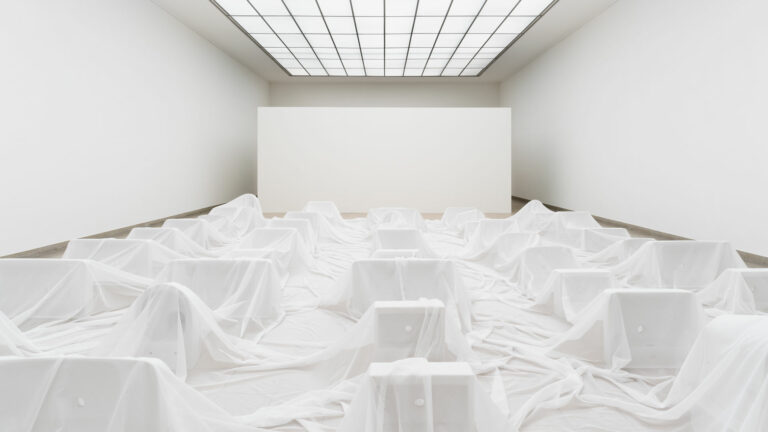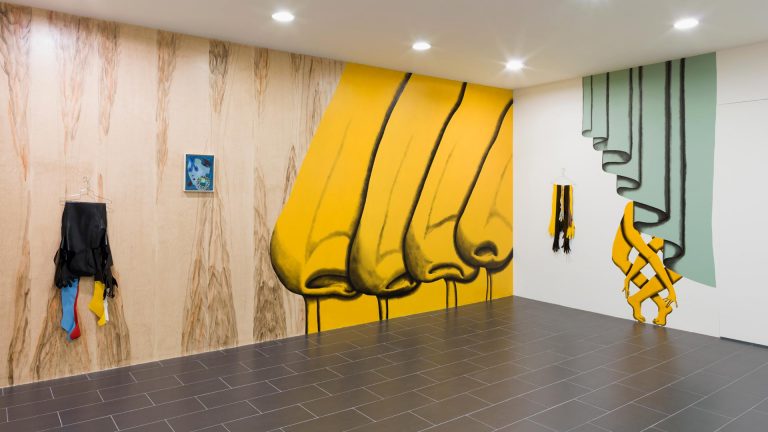Artist: Miriam Visaczki
Exhibition title: Ot Otijot
Venue: KIRCHGASSE, Steckborn, Switzerland
Date: January 22 – March 20, 2022
Photography: images copyright and courtesy of the artist and KIRCHGASSE, Steckborn
Ot Otijot1
Quarantine has just ended and on the way to meet Miriam at K-strasse. Crossing the river and start to think about the Clyde, not so much the Spree or Berlin, and about Glasgow and some pix I took there on another walk, the last time I was out on foot in a city. They were all of buildings encountered along a west-to-east axis into the city center. An array of domestic, municipal, commercial and industrial architectures, and an explicit mesh and melt of timeframes, of material and ideological vectors: 18th and 19th century mercantile opulence, postwar high-rises, stretches of sandstone tenements, ancient brick warehouses, cramped post-Thatcher apartment blocks. Prefab superstores at the edge of the river. A stained brutalist plaza backdropped by looming post-crisis glass towers. Illuminated logos and metal shutters. A multitude of chiseled inscriptions and ornate stone carvings. Moss. Fences behind fences, bridges and elevated walkways. The university on the hill.
I cross the street and see the guy with the ponytail from the local copyshop release clouds of vape smoke, returning me to this here-and-now, and ring the buzzer at Miriam‘s.
The Hebrew book of Jonah is a short text. It must have existed already in the second century BCE2. Jonah is part of the biblical canon and belongs to the later prophets in the Tanakh3. Both Christianity as well as Islam have included Jonah in their tradition. The Hebrew text focuses less on a prophecy than on the inner struggle of a prophet. While the Jewish Jewish reception sees Jonah as a «symbolic figure for the way through death to new life»4 Jonah is the «prototype for repentance and resurrection» in Christianity5. Jonah was seen as a reference to the death and resurrection of Jesus, too6. The Koran also mentions him in six suras: Yunus – or «the companion of the great fish»7. Yunus is not so much a torn prophet than an «example of a repentant sinner who becomes a believer»8. Muhammad says about himself that «he is not more important than Moses or Jonah»9.
Jonah is commissioned by G*d10 to go to the city of Nineveh11 and call the people there to repentance and reversion. However, Jonah departs in the opposite direction and boards a ship in Jaffo12 in the direction of Tarsis. He hopes not to be recruited in faraway Tarsis, since the people there know nothing of G*d13. After he boards the ship, a violent storm comes up, which destroys the ship. Jonah flees into the belly of the ship and wants to go to sleep, to the great incomprehension of the other men, who pray to their respective deities to avert the disaster. By casting lots, they find out that Jonah is the cause of the storm. Jonah confesses that he is running away from G*d. When asked what they should do with him, Jonah requests them to throw him into the sea, for only in this way can calm return. After a short hesitation the men comply with his request and throw him into the sea. And the storm stops. G*d now lets a large fish swallow Jonah «and Jonah remained in the fish’s belly three days and three nights»14.
In 2011, near the Sea of Galilee, the Huqoq Synagogue, built between the fourth and sixth century BCE, was excavated. A mosaic panel depicts the sea and the ship and Jonah’s legs and feet dangling from a large fish. The fish that swallows him is swallowed by another fish, which in turn is devoured by another15. In the Qur’an, Yunus is also devoured by three fish in succession. Here, the fish are even transparent, so that Yunus is able to marvel at the wonders of the depth and hear the praises of the sea monsters. And the angels hear his prayers from inside the fish16.
The Jonah of the Hebrew Bible confesses to G*d in the belly of the great fish and thanks for his rescue from the depth of the sea. And G*d speaks to the fish, so that it spits Jonah out on land. Jonah now sets out for Nineveh. He walks around in the «enormously large city – a three days’ walk across»17 and calls out: «Forty days more, and Nineveh shall be overthrown!»18. And the people of Nineveh confess to G*d. Even the king scatters ashes on his head and orders everyone to wrap in sackcloth, fast and cry out to G*d, even the animals. And G*d changes the plan – Nineveh is spared.
Because of the theme of repentance and reversion, the Book of Jonah is read on Yom Kippur, the Jewish Day of Atonement, a strict fast and repentance day19. In the Islamic tradition, the acts of repentance of the people of Nineveh are associated with Ashura20, a voluntary fast day that Muhammad adopted from Judaism21.
Jonah is very upset about G*d’s act of mercy. He prays and wishes for death. And it now becomes clear why Jonah did not want to be recruited for this mission in the first place. He knew he would have to predict something in Nineveh that would not come to pass. Jonah leaves Nineveh and settles outside the city. G*d wants Jonah to understand and lets a tree grow over him which provides shade from the heat which Jonah enjoys. The following day G*d sends worms that wither the tree and a sultry wind that plagues Jonah and makes him long for death once again. And G*d explains to Jonah: «You mourn for a tree for which you had no trouble, and I am to have no compassion for the many people of Nineveh?».
Miriam unpacks the pieces for the exhibition. She is working with colored pencil on black MDF. Miriam mentions the twisting and stretching of primary geometric forms and aspects of applied modernism which informed her school education and its environment. We also look at the text from her last exhibition (a two-person show with Flora) and talk about abstraction, scientific and botanical illustration, affect, surrealism, synthesis, technical notation and illuminated manuscripts. We get to animals and fruit in fables. I learn about the page format of the Talmud, its inherently mediative structure, and about her study of Hebrew. She is also currently writing about Jona(h). We talk about learning languages and reading one text through another (or one image through another). Miriam seems resolute and the set of work seems deftly conjured and an intently serious sort of casual, one both meticulously mapped and loosely or rather innately formed. I look over the text from Das Band again, «the viewer is drawn along from one panel to the next […] the drawings demand to be viewed up close in order for them to be visible in their detail ― one‘s pupils dilate.» I drift slightly, thinking that it would be fantastic to see Miriam‘s work hung in the exhibition at Kirchgasse right now but then just as much along a library corridor, in a foyer of the FU Berlin, or as the backdrop to a livestreamed podium discussion at Basel. Multifaceted―is that a thing? Miriam briskly relays her aversion to postures of edged cynicism and then Rio comes over from next door to demonstrate some new choreography. We drink some tea and I tell Miriam I‘ll send her some notes soon.
Dark out now and back across the Moabiter Brücke, there‘s the rattle and screech of the S-Bahn and three carriages are fully tagged. Look great, awesome colors too. I think these are surfaces that inscribe as letter and letters stream by.
-K.A. Kolenda Miriam Visaczki
- Ot means letter, sign in Hebrew. Otijot is the plural form of Ot.
- Gerhards, M., Jona / Jonabuch, Das Wissenschaftliche Bibellexikon im Internet (2008), p. 5, https://www. bibelwissenschaft.de/fileadmin/buh_bibelmodul/media/wibi/pdf/Jona_Jonabuch__2018-12-03_22_10. pdf (accessed 7 Jan. 2022).
- The Tanakh is the Hebrew Bible. Tanakh is an acronym formed from the initial letters of Torah (Five Books of Moses), Nevi’im (Prophets) und Ketuvim (Writings).
- Gerhards, p. 31.
- Vorpahl, D., Vom Voraussetzen und Wiederentdecken des Narrativ. Die islamische Yūnus-Rezeption im Lichte jüdischer Jona-Traditionen, In: PaRDeS. Zeitschrift der Vereinigung für Jüdische Studien e.V. 22 (2016), p. 34, https://publishup.uni-potsdam.de/opus4-ubp/frontdoor/deliver/index/docId/9960/file/ pardes22_31-48.pdf (accessed 7 Jan. 2022).
- Gerhards, p. 31.
- Ibid., p. 40.
- Ibid., p. 37.
- Ibid., p. 41.
- Out of respect for the divine name, many Jews use the spelling G-d. In order to proceed in this text non-binary, the gender star is being used, like an additional layer of respect.
- Ancient Nineveh was located in modern-day Mosul in northern Iraq.
- The ancient port city Jaffo or Jaffa is part of Tel Aviv-Yafo today.
- Gerhards, p. 8.
- JPS Tanakh translation (1985), https://www.sefaria.org/Jonah.2.1?ven=Tanakh:_The_Holy_Scriptures,_ published_by_JPS&vhe=Miqra_according_to_the_Masorah&lang=bi&with=all&lang2=en (accessed 21 Feb. 2022).
- Magness, J. u.a., Inside the Huqoq Synagogue, In: Biblical Archaeological Review 45 (2019), p. 24f, 38, https://www.baslibrary.org/sites/default/files/inside_the_huqoq_synagogue.pdf (accessed 7 Jan. 2022).
- Heller, B. / Rippin, A., Yunus, Encyclopaedia of Islam, Second Edition (2012), http://dx.doi.org/
- JPS Tanakh translation (1985), https://www.sefaria.org/Jonah.3.3?ven=Tanakh:_The_Holy_Scriptures,_ published_by_JPS&vhe=Miqra_according_to_the_Masorah&lang=bi&with=all&lang2=en (accessed 21 Feb. 2022).
- JPS Tanakh translation (1985), https://www.sefaria.org/Jonah.3.4?ven=Tanakh:_The_Holy_Scriptures,_ published_by_JPS&vhe=Miqra_according_to_the_Masorah&lang=bi&with=all&lang2=en (accessed 21 Feb. 2022).
- Vorpahl, p. 45.
- Ibid.
- Wensinck, A.J. / Marçais, Ph., Ashura, Encyclopaedia of Islam, Second Edition (2012), http://dx.doi. org/10.1163/1573-3912_islam_COM_0068 (accessed 7 Jan. 2022).
Miriam Visaczki, OT OTIJOT, installation view at Kirchgasse Gallery, 2022 / Photo: CE / Courtesy: the artist and Kirchgasse Gallery
Miriam Visaczki, Ohne Titel, Watercolor pencil on MDF, 30 × 40 × 1cm, 2021/ Photo: CE / Courtesy: the artist and Kirchgasse Gallery
Miriam Visaczki, Ohne Titel, Watercolor pencil on MDF, 30 × 40 × 1cm, 2021/ Photo: CE / Courtesy: the artist and Kirchgasse Gallery
Miriam Visaczki, OT OTIJOT, installation view at Kirchgasse Gallery, 2022 / Photo: CE / Courtesy: the artist and Kirchgasse Gallery
Miriam Visaczki, OT OTIJOT, installation view at Kirchgasse Gallery, 2022 / Photo: CE / Courtesy: the artist and Kirchgasse Gallery
Miriam Visaczki, Ohne Titel, Watercolor pencil on MDF, 40 × 30 × 1cm, 2021/ Photo: CE / Courtesy: the artist and Kirchgasse Gallery
Miriam Visaczki, OT OTIJOT, installation view at Kirchgasse Gallery, 2022 / Photo: CE / Courtesy: the artist and Kirchgasse Gallery
Miriam Visaczki, Feigenblatt / Fig Leaf, Wool and Wood, 60 × 90cm, 2021 / Photo: CE / Courtesy: the artist and Kirchgasse Gallery
Miriam Visaczki, OT OTIJOT, installation view at Kirchgasse Gallery, 2022 / Photo: CE / Courtesy: the artist and Kirchgasse Gallery
Miriam Visaczki, Ohne Titel, Watercolor pencil on MDF, 30 × 40 × 1cm, 2021/ Photo: CE / Courtesy: the artist and Kirchgasse Gallery
Miriam Visaczki, Ohne Titel, Watercolor pencil on MDF, 30 × 40 × 1cm, 2021/ Photo: CE / Courtesy: the artist and Kirchgasse Gallery
Miriam Visaczki, OT OTIJOT, installation view at Kirchgasse Gallery, 2022 / Photo: CE / Courtesy: the artist and Kirchgasse Gallery
Miriam Visaczki, Ohne Titel, Watercolor pencil on MDF, 30 × 40 × 1cm, 2021/ Photo: CE / Courtesy: the artist and Kirchgasse Gallery
Miriam Visaczki, OT OTIJOT, installation view at Kirchgasse Gallery, 2022 / Photo: CE / Courtesy: the artist and Kirchgasse Gallery
Miriam Visaczki, OT OTIJOT, installation view at Kirchgasse Gallery, 2022 / Photo: CE / Courtesy: the artist and Kirchgasse Gallery
Miriam Visaczki, OT OTIJOT, installation view at Kirchgasse Gallery, 2022 / Photo: CE / Courtesy: the artist and Kirchgasse Gallery
Miriam Visaczki, Ohne Titel, Watercolor pencil on MDF, 40 × 30 × 1cm, 2021/ Photo: CE / Courtesy: the artist and Kirchgasse Gallery
Miriam Visaczki, Ohne Titel, Watercolor pencil on MDF, 40 × 30 × 1cm, 2021/ Photo: CE / Courtesy: the artist and Kirchgasse Gallery
Miriam Visaczki, Ohne Titel, Watercolor pencil on MDF, 40 × 30 × 1cm, 2021/ Photo: CE / Courtesy: the artist and Kirchgasse Gallery
Miriam Visaczki, OT OTIJOT, installation view at Kirchgasse Gallery, 2022 / Photo: CE / Courtesy: the artist and Kirchgasse Gallery
Miriam Visaczki, Pflanzen / Plantsm Watercolor pencil on MDF, 14,5 × 19 × 1 cm, 2022 / Photo: CE / Courtesy: the artist and Kirchgasse Gallery
Miriam Visaczki, OT OTIJOT, installation view at Kirchgasse Gallery, 2022 / Photo: CE / Courtesy: the artist and Kirchgasse Gallery
Miriam Visaczki, OT OTIJOT, installation view at Kirchgasse Gallery, 2022 / Photo: CE / Courtesy: the artist and Kirchgasse Gallery
Miriam Visaczki, Ohne Titel, Watercolor pencil on MDF, 40 × 30 × 1cm, 2021/ Photo: CE / Courtesy: the artist and Kirchgasse Gallery
Miriam Visaczki, Ohne Titel, Watercolor pencil on MDF, 40 × 30 × 1cm, 2021/ Photo: CE / Courtesy: the artist and Kirchgasse Gallery
Miriam Visaczki, Ohne Titel, Watercolor pencil on MDF, 40 × 30 × 1cm, 2021/ Photo: CE / Courtesy: the artist and Kirchgasse Gallery
Miriam Visaczki, OT OTIJOT, installation view at Kirchgasse Gallery, 2022 / Photo: CE / Courtesy: the artist and Kirchgasse Gallery
Miriam Visaczki, OT OTIJOT, installation view at Kirchgasse Gallery, 2022 / Photo: CE / Courtesy: the artist and Kirchgasse Gallery

